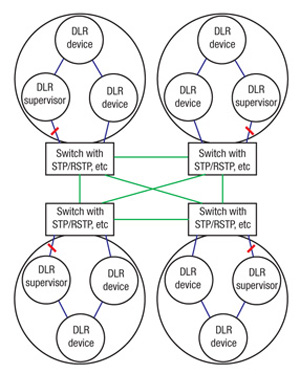Device Level Ring (DLR) is a Layer 2 protocol that provides media redundancy in a ring topology. The DLR protocol is intended primarily for implementation in CP 2/2 end devices that have multiple Ethernet ports and embedded switch technology. The DLR protocol provides for fast network fault detection and reconfiguration in order to support the most demanding control applications.
Since DLR protocol operates at Layer 2 (in the OSI network model), the presence of the ring topology and the operation of the DLR protocol are transparent to higher layer protocols such as TCP/IP and CP 2/2, with the exception of a DLR object that provides a configuration and diagnostic interface for CP 2/2.

DLR Rings connected to switches
A DLR network includes at least one node configured to be a ring supervisor, and any number of normal ring nodes. It is assumed that all the ring nodes have at least two Ethernet ports and incorporate embedded switch technology.
Ring supervisor node
A DLR network requires that at least one device be configured to act as the Ring Supervisor. This device shall implement these behaviours:
- Verify the integrity of the ring
- Blocking traffic on one of its ports with the exception of DLR protocol proprietary frames and do not forward traffic from one port to another. This way, network loops are avoided, and only one path exits between any two ring nodes during normal operation
- Transmitting Beacon and Announce frames through both of its Ethernet port periodically. The purpose of this is:
- The presence of Beacon and Announce frames in the ring inform nodes to transition from linear to ring topology mode
- Loss of Beacon frames at the supervisor enables the detection of ring faults
- The precedence value present in Beacon is used to select an active supervisor
- Reconfiguring the ring to recover from faults
Beacon-based Ring Node
A ring node or Beacon-based node is any non-supervisor device that operates on the ring and participates in the DLR protocol, but without the ring supervisor capabilities. These beacon-based ring nodes are required to process Beacon frames sent by a ring supervisor within a speci ed beacon interval.
Non-DLR multi-port devices – switches or end devices – may be placed in the ring, subject to certain implementation constraints (e.g., no MAC table filtering). Non-DLR devices will also impact the worst-case ring recovery time.
SoC-e DLR solutions
SoC-e provides technology to integrate these functionalities in the following products:
- Managed Ethernet Switch (MES) IP Core: MES IP Core can implement DLR functionalities as well as many other Ethernet functionalities.
- Managed Redundant Switch (MRS) IP Core: MRS IP Core combines our HSR-PRP Switch and Managed Ethernet Switch, in order to have redundant and non-redundant ports.
